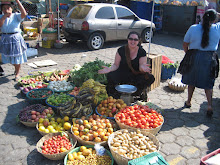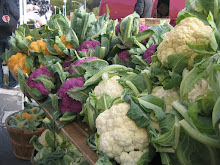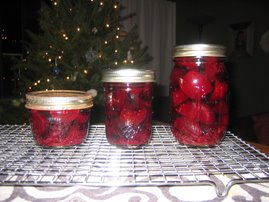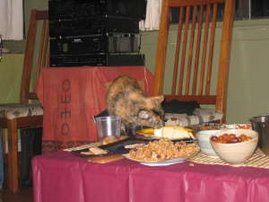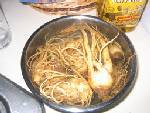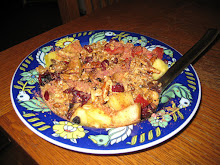
Next weekend in upstate New York, a very good friend of mine is getting married. She found this wonderful guy after a long and storied single life and she's so happy. She asked me a few weeks ago whether friendships with your girlfriends change when you get married (in this case, to a man). I said that the friendships don't change, but for me at least, the time that I spend with my girlfriends is less than I used to. You have to work at it; but also, if they're true friends, you won't lose them. I had already been thinking about what to do for her because she didn't want any gifts for the wedding, and because I feel kind of sad that I didn't have a "bridal shower" kind of thing before I got married. All of my bridal party were from out of town--very good old friends who I wanted to make sure came to the wedding from places as distant as Ramallah. So I took the opportunity of that conversation to ask her if I could host a party for her with her closest women-friends. I thought she would say no, but she was touched, and after some coaxing, sent me email addresses for her friends--none of whom, surprisingly, I knew.

I co-hosted the evening with another friend of hers, and she suggested coordinating the food to make sure we had enough of everything. I decided I would make cupcakes--partly because I love using the cupcake tree my mother gave me a few years ago for Christmas. I also think people like having their own mini-cakes. As the evening drew nearer, I realized I didn't have a clue about what kind of desserts my friend likes. I know she likes margaritas. I know she likes Mexican and Middle Eastern food, but I had no idea about sweets. So I turned to her friends, and to her fiance. I came up with a list of cupcakes that I've wanted to make for a long time from a book
Cupcakes I got for my own wedding. From that list, her fiance chose a rosewater raspberry cupcake, but her friends almost unanimously wrote back and said that my friend loves chocolate. What to do?

Last weekend, D and I went to the country to visit with two couples we love spending time with. After a few bottles of wine, I posed the dilemma: do I make the cupcake chosen by my friend's chosen life partner? A man she's known for a sliver of time compared to the girlfriends--some of whom she's known for more than 25 years? The question served as a platform for a lively discussion among the six of us, all men but for me. They debated back and forth about what the schism meant, and finally one of them suggested that her chosen life partner may know things about her that she doesn't even know yet herself. He may represent a new direction--one that she didn't even know she wanted to take. The argument for the rosewater raspberry was gaining support. But then someone said that I should stay safe with a cupcake that everyone knows she will like--it's her party after all. I decided to compromise and make them both, and see what happens.

It was the right decision. The cupcakes were pretty and yummy. Our guests liked them both, but the chocolate cupcakes that I chose to make were a real hit. At some point in the evening, my friend came over to me and told me how much she loved the chocolate cupcakes. I asked her if she'd tried the rosewater. She wrinkled her nose a little bit and said no, she had to keep it to one because she had a wedding dress to look good in next weekend. So I told her the story. She agreed to try the rosewater cupcakes and the smile on her face after she took a bite was priceless. She said: "I love tart things. [my fiance] knows that." She herself would never have chosen the rosewater, but she liked it a lot.

Finding the ingredients for these two cupcake recipes was a bit of a challenge. Despite thousands--maybe millions--of Mexican bodegas and supermercados in NYC, I couldn't find Mexican chocolate. So I substituted a Dagoba hot chocolate cocoa called Xocolatl and reduced the sugar in the recipe. The rosewater called for sugared rose petals as a decoration, and I thought I'd be too busy this week to make them on my own, so I found them at
Kalustyan's in Kip's Bay. Unfortunately, they weren't as pretty as ones I would have made on my own, and next time I won't shy away from the task.

Mexican Chocolate Cupcakes1 cup flour
1/2 cup sugar
1/4 cup xocolatl (Mexican drinking chocolate--see above)
3/4 tsp baking soda
1 1/2 tsp cinnamon
1/4 tsp salt
3/4 cup lukewarm water
1/3 cup canola oil
3/4 tsp white vinegar
1/2 cup finely grated semi-sweet chocolate, plus a little extra for garnish
Buttercream frosting
Preheat oven to 350 degrees. Line a 12-cup muffin tin with paper liners. Sift together the flour, sugar, cocoa powder, baking soda, 1 1/2 tsp of cinnamon, and the salt into a bowl. Add the water, oil, and vinegar to the flour mixture, using an electric mixer on medium speed, beat until combined. Add the 1/2 cup of chocolate and beat until well combined.
Divide the batter evenly into the paper liners filling to about 3/4 full. Bake until a toothpick is inserted in the center of a cupcake comes out clean, 24-28 minutes. Let the cupcakes cool in the pan for 5 minutes, then transfer to a wire rack to let cool completely before frosting--about one hour.
Frost with buttercream (I used a chocolate buttercream using the xocolatl again) and garnish with grated chocolate.
Rosewater & Raspberry Cupcakes1 1/4 cup flour
1 tsp baking powder
1/4 tsp salt
3/4 confectioner's sugar
1/2 cup unsalted butter, at room temp
1 tbsp rosewater
2 large eggs, at room temp
1/2 cup milk
Rosewater glaze
12 raspberries
Sugared rose petals
Preheat oven to 350 degrees; line a muffin tin with paper liners.
Whisk together the flour, baking powder, and salt. In another bowl, with an electric mixer on medium-high speed, beat the confectioner's sugar and butter together until light and fluffy--about 2-3 minutes. Add the rosewater and the eggs, one at a time, beating on low speed until combined after each addition. Add the flour in three additions, alternating with the milk in two. Beat on low speed until well combined.
Divide the batter evenly among the muffin cups, filling each to about 3/4 full. Bake until lightly golden and a toothpick inserted into the center of a cupcake comes out clean, 15-18 minutes. Let the cupcakes cool in the tin for 5 minutes, then transfer to a wire rack and let cool completely for about an hour.

When cooled, spoon a small amount of glaze on each cupcake and garnish with sugared rose petals. Depending on what colors you get with each, you may want to add a raspberry on top. My rose petals were too dark and wouldn't have looked good with the raspberries, so I baked my raspberries into the center of each cupcake. (I did this by filling the muffin cups 1/2 full, pressing a raspberry in the center, and then covering with another dollop of batter).

 For the past few years, we've spent the week between Christmas and New Years at beautiful country house in Pennsylvania owned by very dear friends of ours. Whenever we're here, we get inspired to cook up some new dish. This year, I found a recipe for arepas with pulled pork and cheese in the Food & Wine magazine that our friends subscribe to. I looked in a few places here in the country for one of the arepas ingredients: masa harina, but couldn't find it. I thought I could substitute corn meal, but it didn't work. We adapted the recipe and instead made little corn cakes with pulled pork in the center. We served is as part of our little New Year's Day spread for a few friends who stopped by. They were delicious topped with sour cream, pickled cabbage, sliced jalapeno and chopped cilantro. We bought the pork from a local German place up here that sources their meat locally and does all their own butchering called the Alpine House.
For the past few years, we've spent the week between Christmas and New Years at beautiful country house in Pennsylvania owned by very dear friends of ours. Whenever we're here, we get inspired to cook up some new dish. This year, I found a recipe for arepas with pulled pork and cheese in the Food & Wine magazine that our friends subscribe to. I looked in a few places here in the country for one of the arepas ingredients: masa harina, but couldn't find it. I thought I could substitute corn meal, but it didn't work. We adapted the recipe and instead made little corn cakes with pulled pork in the center. We served is as part of our little New Year's Day spread for a few friends who stopped by. They were delicious topped with sour cream, pickled cabbage, sliced jalapeno and chopped cilantro. We bought the pork from a local German place up here that sources their meat locally and does all their own butchering called the Alpine House.  To assemble the fritters, drop a heaping tablespoon of the batter into smoking oil in a frying pan. When the batter begins to solidify, drop a ball of the pork-cheese mixture in the center, and top with another tablespoon of the batter. When the "pancake" has some integrity, flip to the other side and fry until golden. Drain on a paper towel.
To assemble the fritters, drop a heaping tablespoon of the batter into smoking oil in a frying pan. When the batter begins to solidify, drop a ball of the pork-cheese mixture in the center, and top with another tablespoon of the batter. When the "pancake" has some integrity, flip to the other side and fry until golden. Drain on a paper towel. 











































